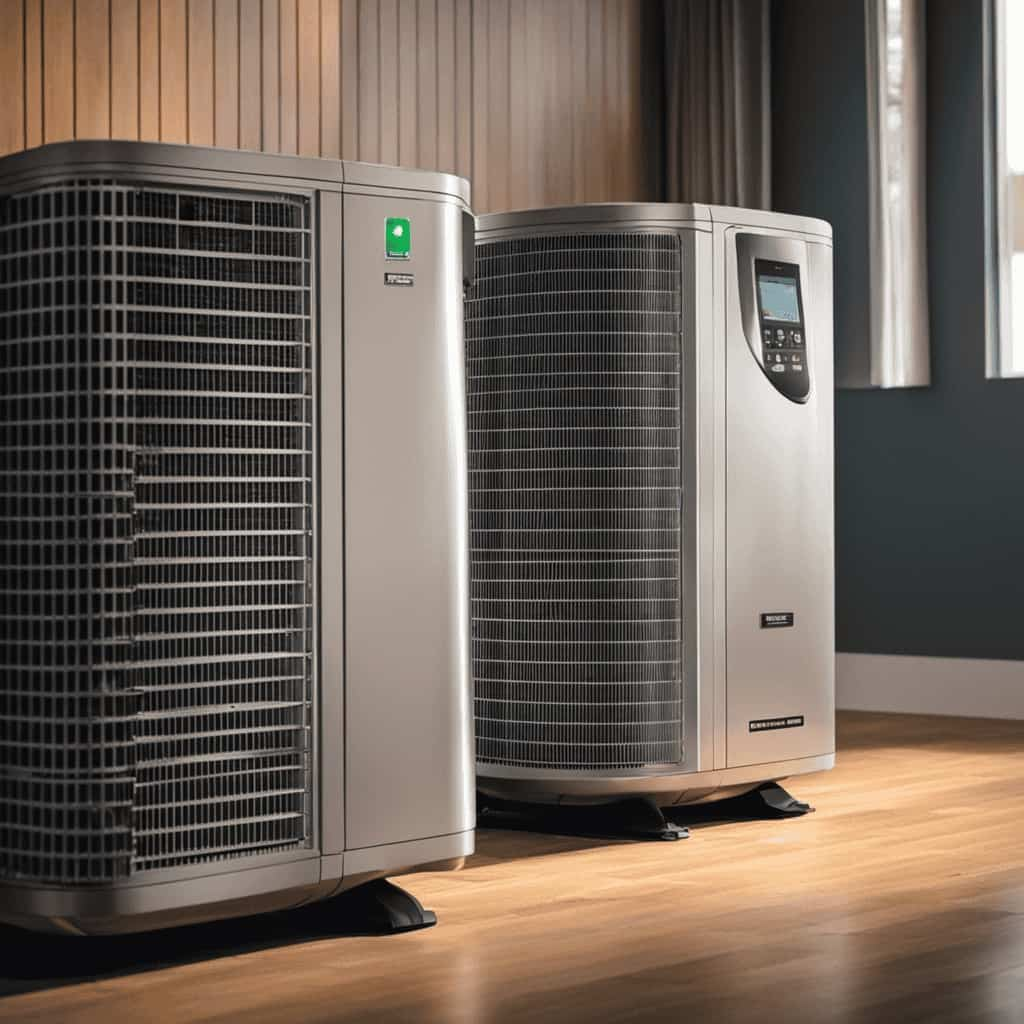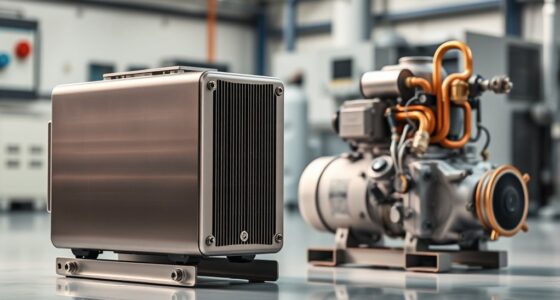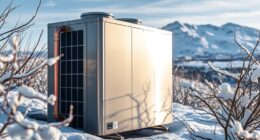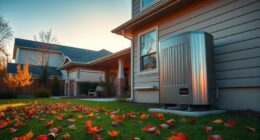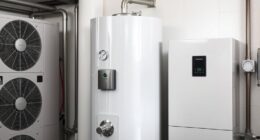Welcome back to our delve into widespread issues with air conditioning heat pumps.
Today, we delve into the intricate world of heat pump malfunctions, troubleshooting, and solutions.
Brace yourselves for a whirlwind journey through low cooling efficiency, refrigerant leaks, icing problems, noisy operations, and cycling issues.
Get ready to equip yourself with the knowledge and tools needed to conquer these challenges head-on.
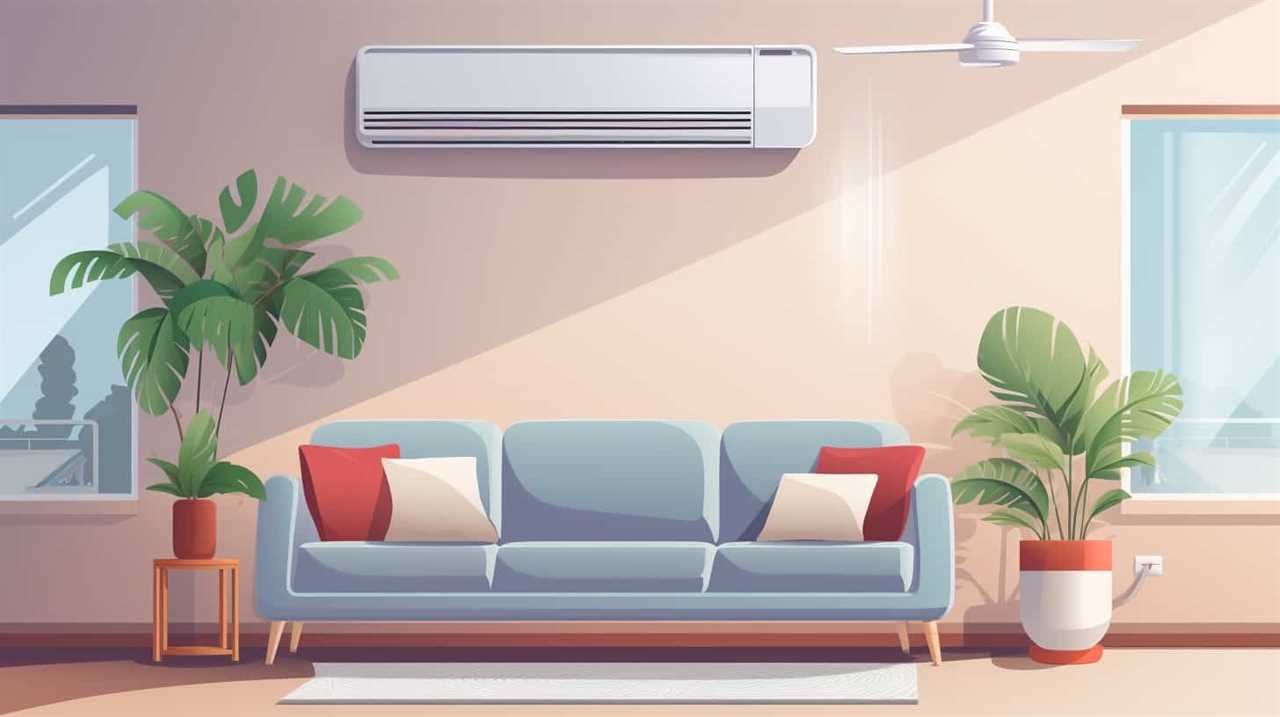
Together, let’s conquer the heat and serve your cooling needs with confidence.
Key Takeaways
- Regular maintenance is crucial in preventing heat pump failure and ensuring optimal performance.
- Signs of a malfunctioning heat pump include lack of heating or cooling, increased energy bills, and strange noises.
- Troubleshooting low cooling efficiency involves checking refrigerant levels, inspecting for leaks, and cleaning filters and outdoor units.
- Refrigerant leaks should be detected and repaired promptly to prevent further damage.
Common Causes of Heat Pump Failure
We have identified several common causes of heat pump failure.
One of the primary factors is improper heat pump maintenance. Regular maintenance is crucial to ensuring the longevity and optimal performance of a heat pump. Neglecting routine maintenance tasks such as cleaning or replacing filters, inspecting electrical connections, and lubricating moving parts can lead to significant issues down the line.
Another common cause of heat pump failure is exceeding the heat pump lifespan. Like any mechanical system, heat pumps have a finite lifespan. Over time, wear and tear can take a toll on the components, leading to decreased efficiency and eventual failure. It’s essential to keep track of the age of the heat pump and plan for replacement when necessary to avoid unexpected breakdowns.
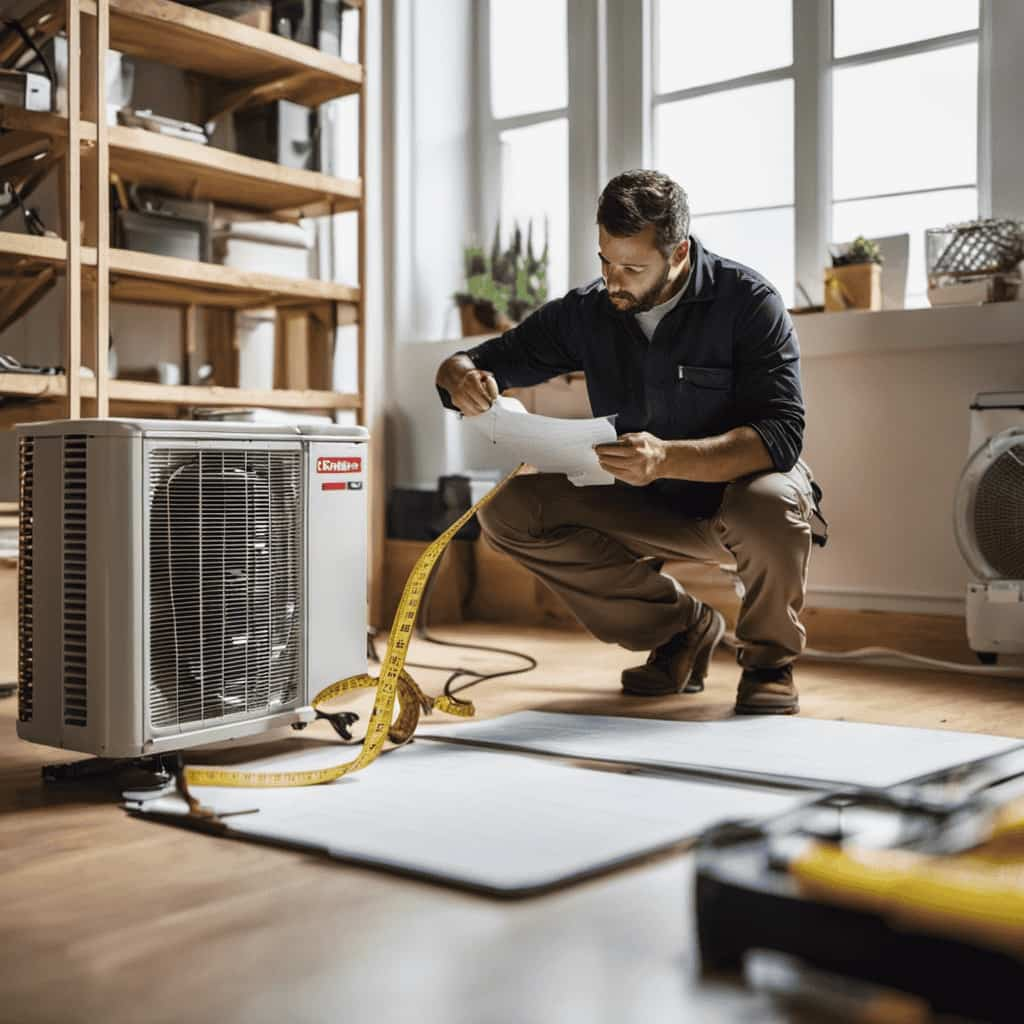
Signs of a Malfunctioning Heat Pump
One of the primary indicators of a malfunctioning heat pump is a lack of heating or cooling in the home. If you notice that your heat pump isn’t providing the desired temperature, it could be a sign of a problem.
Another common sign is an increase in your energy bills without a change in usage. This could indicate that your heat pump is working harder and less efficiently.
Additionally, if you hear strange noises coming from your heat pump, such as grinding or screeching sounds, it could be a sign of compressor failure. It’s important to address these issues promptly to avoid further damage and costly repairs.
Regular heat pump maintenance, such as cleaning the coils and changing the air filters, can help prevent these problems and ensure optimal performance.

Troubleshooting Low Cooling Efficiency
Our first step in troubleshooting low cooling efficiency is to check the refrigerant levels in the heat pump. Proper refrigerant levels are crucial for the optimal functioning of the system. Here are four key aspects to consider when trying to improve energy efficiency and optimize cooling performance:
-
Inspect for refrigerant leaks: Leaks can cause a decrease in refrigerant levels, leading to reduced cooling efficiency. Detecting and repairing any leaks is essential to maintain the proper refrigerant levels.
-
Clean the outdoor unit: Dust, dirt, and debris can accumulate on the outdoor unit, causing airflow restrictions and hindering cooling performance. Regularly cleaning the unit helps improve efficiency.
-
Check the air filters: Dirty or clogged air filters can impede airflow, forcing the system to work harder to cool the space. Cleaning or replacing the filters allows for better airflow and enhances energy efficiency.
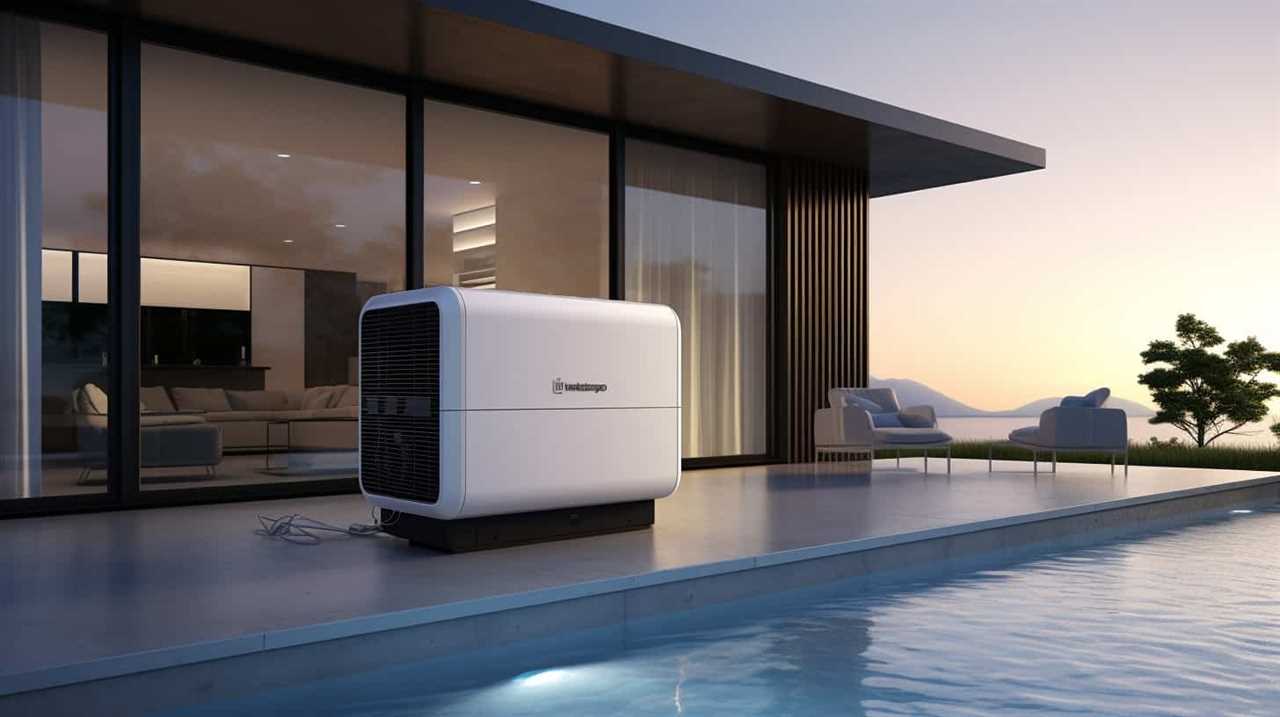
-
Ensure proper insulation: Insufficient insulation can result in cool air escaping and warm air entering the space. Properly insulating the area helps maintain a consistent temperature and improves cooling efficiency.
Dealing With Heat Pump Refrigerant Leaks
When it comes to heat pump refrigerant leaks, detecting them early is crucial.
We can usually identify refrigerant leaks by inspecting the system for oil stains, ice buildup, or hissing sounds.
Once the leak is located, we’ll need to repair it promptly to prevent further damage to the heat pump and ensure optimal cooling efficiency.
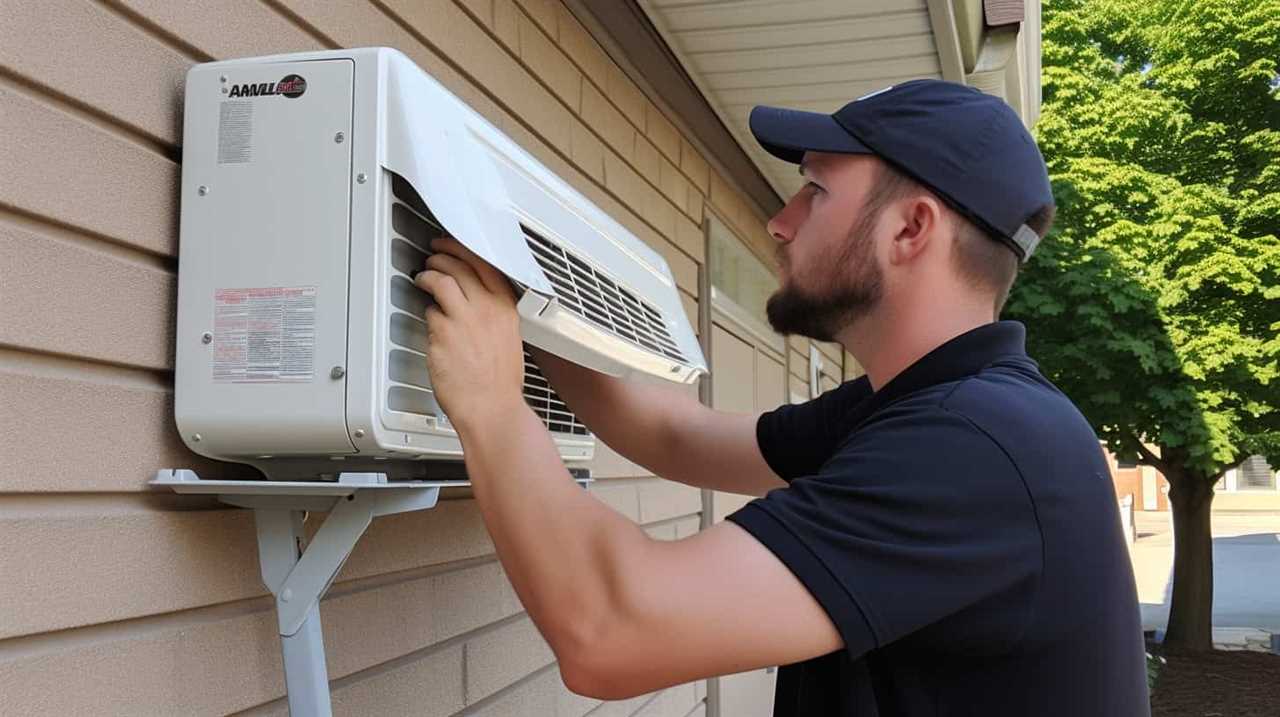
Detecting Refrigerant Leaks
If you suspect a refrigerant leak in your heat pump, it’s important to act promptly to prevent further damage and ensure optimal performance. Here are four important points to consider when it comes to detecting refrigerant leaks:
-
Visual inspection: Check for any signs of oil stains or residue around the heat pump unit, as this could indicate a refrigerant leak.
-
Electronic leak detectors: These handheld devices can detect refrigerant leaks by sensing the presence of certain gases. They’re highly accurate and can help locate leaks quickly.
-
UV dye detection: Adding a UV dye to the refrigerant can make leaks easier to detect. By using a UV light, technicians can identify any leaks by the presence of fluorescent dye.
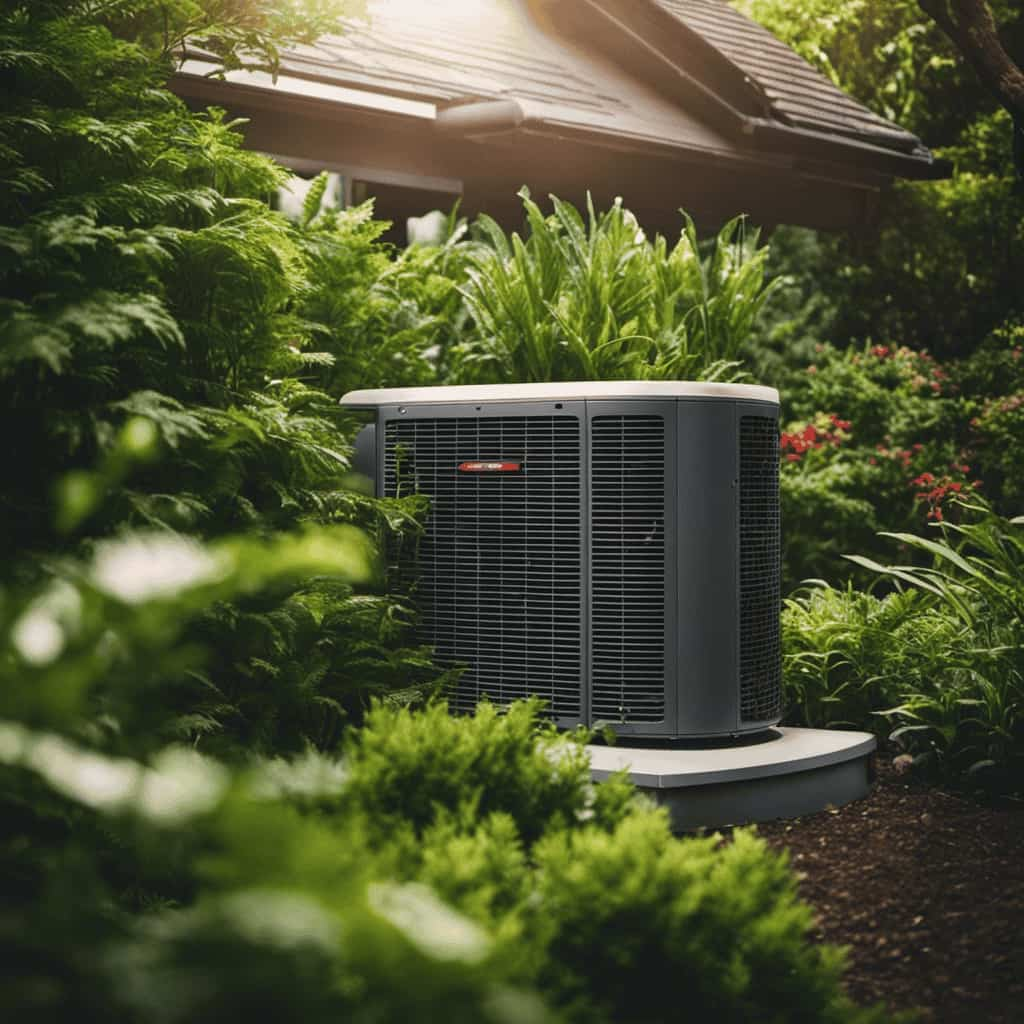
-
Pressure testing: This method involves pressurizing the heat pump with nitrogen gas and monitoring for any pressure drops. A drop in pressure indicates a refrigerant leak.
Detecting refrigerant leaks is crucial because the consequences of these leaks can be significant. Refrigerant leaks not only reduce the cooling or heating capacity of the heat pump, but they can also lead to higher energy consumption, increased repair costs, and potential damage to the compressor.
Therefore, it’s vital to detect and fix these leaks as soon as possible to ensure the efficient operation of your heat pump.
Repairing Refrigerant Leakages
Let’s address the process of repairing refrigerant leakages in heat pumps, which involves locating the source of the leak and sealing it to restore proper functioning.
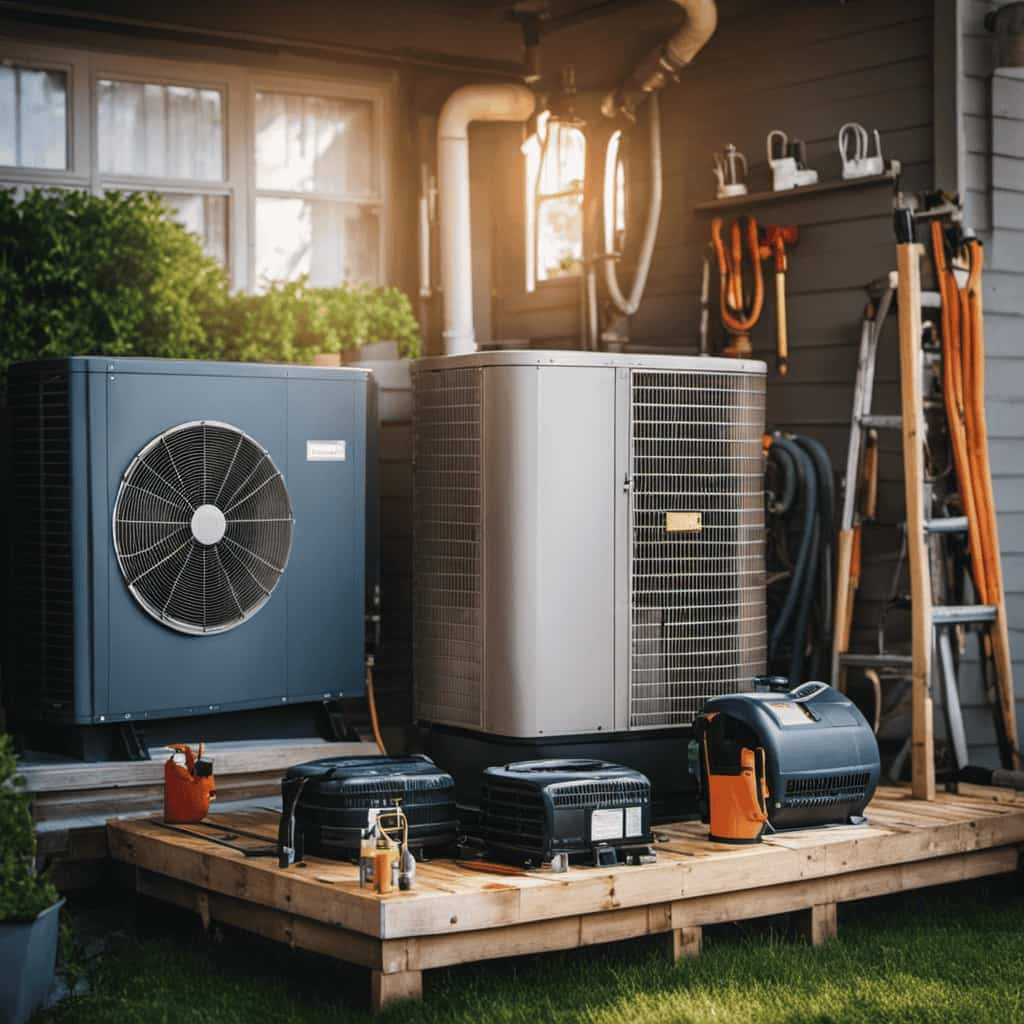
Repairing refrigerant leakages is essential to ensure that the heat pump operates efficiently and maintains optimal cooling or heating performance.
Troubleshooting refrigerant leaks typically begins with a thorough inspection of the system to identify any signs of leakage, such as oil stains or refrigerant residue.
Once the source of the leak is located, it’s important to repair it promptly to prevent further refrigerant loss. This can involve replacing damaged components, such as valves, fittings, or coils, and using appropriate sealing techniques to prevent future leaks.
Additionally, it’s crucial to recharge the system with the correct amount of refrigerant to restore its cooling or heating capacity.

How to Fix Heat Pump Icing Issues
Let’s now address the common issue of heat pump icing and how to fix it.
To prevent heat pump icing, it’s important to ensure proper airflow by regularly cleaning or replacing air filters and checking for any obstructions around the outdoor unit.
When troubleshooting ice buildup, it’s crucial to inspect the refrigerant levels, as low levels can lead to icing.
Lastly, if ice has already formed, dealing with defrosting is necessary, which can be done by activating the heat pump’s defrost mode or manually melting the ice using warm water or a specialized de-icing solution.
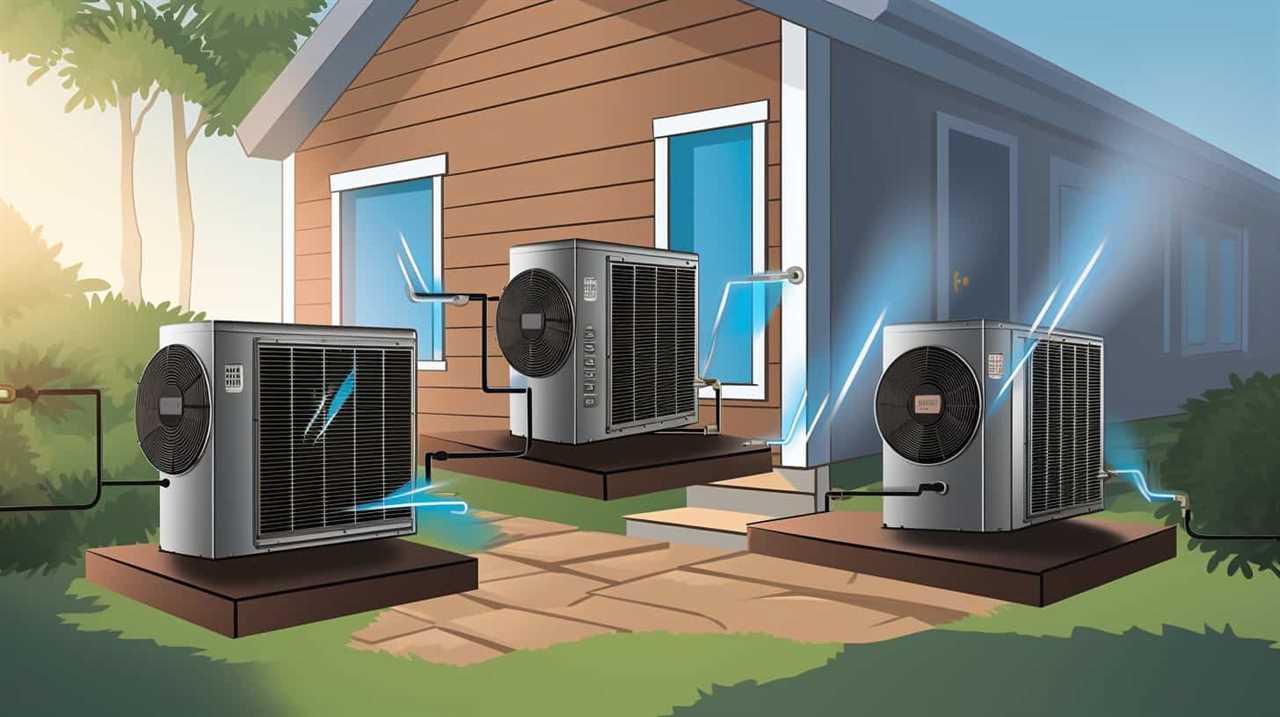
Preventing Heat Pump Icing
To prevent heat pump icing, we should regularly check and clean the outdoor unit, ensure proper airflow, and maintain sufficient refrigerant levels. Here are four important steps to follow in order to prevent frost formation and manage condensation levels:
-
Clean the outdoor unit: Regularly remove any debris, leaves, or dirt that may accumulate on the outdoor unit. This will help maintain optimal airflow and prevent the formation of ice.
-
Inspect and clean the evaporator coils: Over time, the evaporator coils can become dirty and obstructed, leading to reduced airflow and potential icing. Regularly inspect and clean these coils to ensure proper heat exchange.
-
Check and replace air filters: Clogged air filters restrict airflow and can contribute to icing. Check and replace air filters regularly to maintain proper airflow and prevent frost formation.
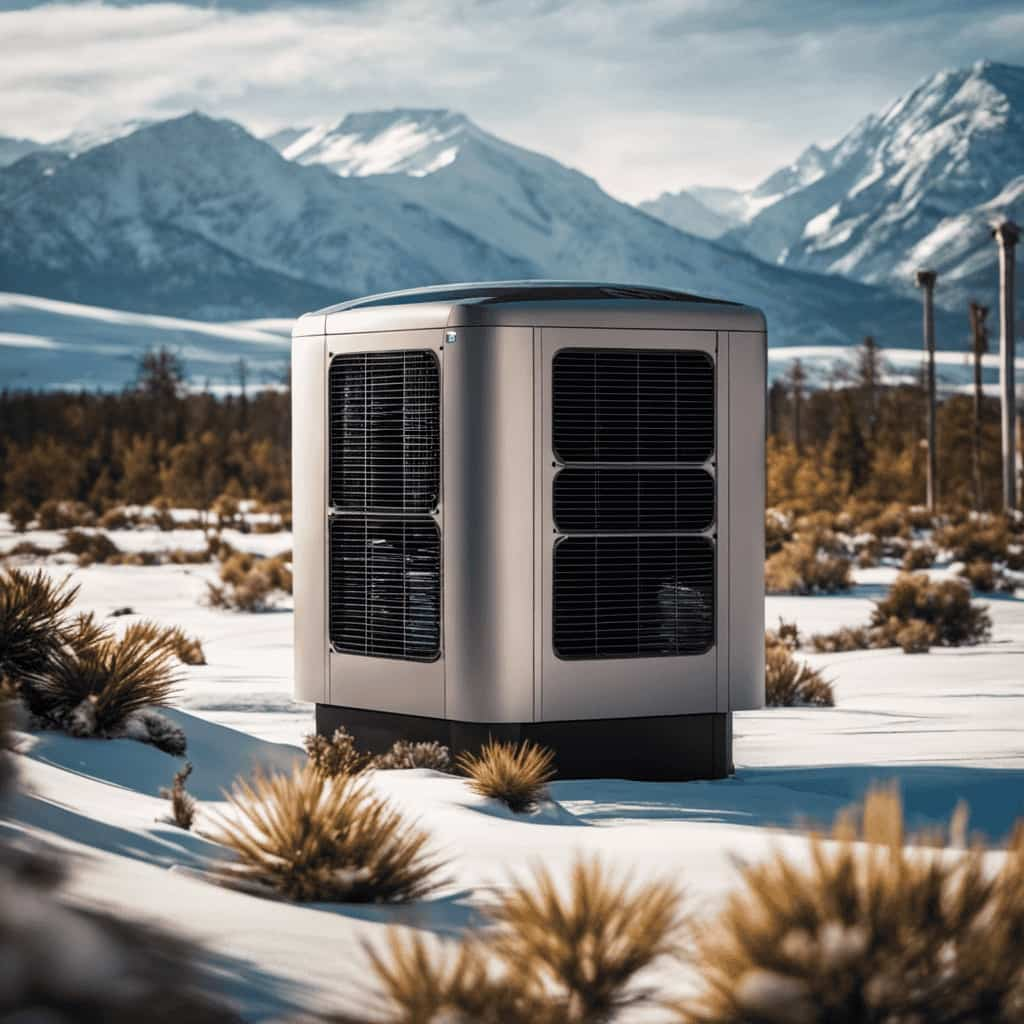
-
Maintain sufficient refrigerant levels: Low refrigerant levels can cause the heat pump to run inefficiently and result in icing. Regularly check and maintain the appropriate refrigerant levels to prevent icing issues.
Troubleshooting Ice Buildup
We can troubleshoot ice buildup on a heat pump by identifying the cause and taking appropriate steps to fix the issue. Preventing ice formation is crucial for the efficient operation of the heat pump.
One common cause of ice buildup is poor airflow, which can be caused by clogged air filters or blocked vents. By regularly cleaning or replacing air filters and ensuring proper airflow, we can prevent ice formation.
Another potential cause is a malfunctioning defrost control board or sensor. Troubleshooting defrosting issues involves checking these components for any faults and replacing them if necessary.

It’s also important to ensure that the heat pump isn’t operating in extremely low temperatures, as this can lead to ice buildup.
By addressing these issues, we can effectively troubleshoot ice buildup and ensure the proper functioning of the heat pump.
Transitioning into the subsequent section about ‘dealing with defrosting’, we’ll now explore the steps to take when faced with a defrosting issue.
Dealing With Defrosting
When faced with heat pump icing issues, it’s important to address the problem promptly in order to prevent further damage and ensure optimal performance. Here are some steps to help you troubleshoot and fix defrosting problems:
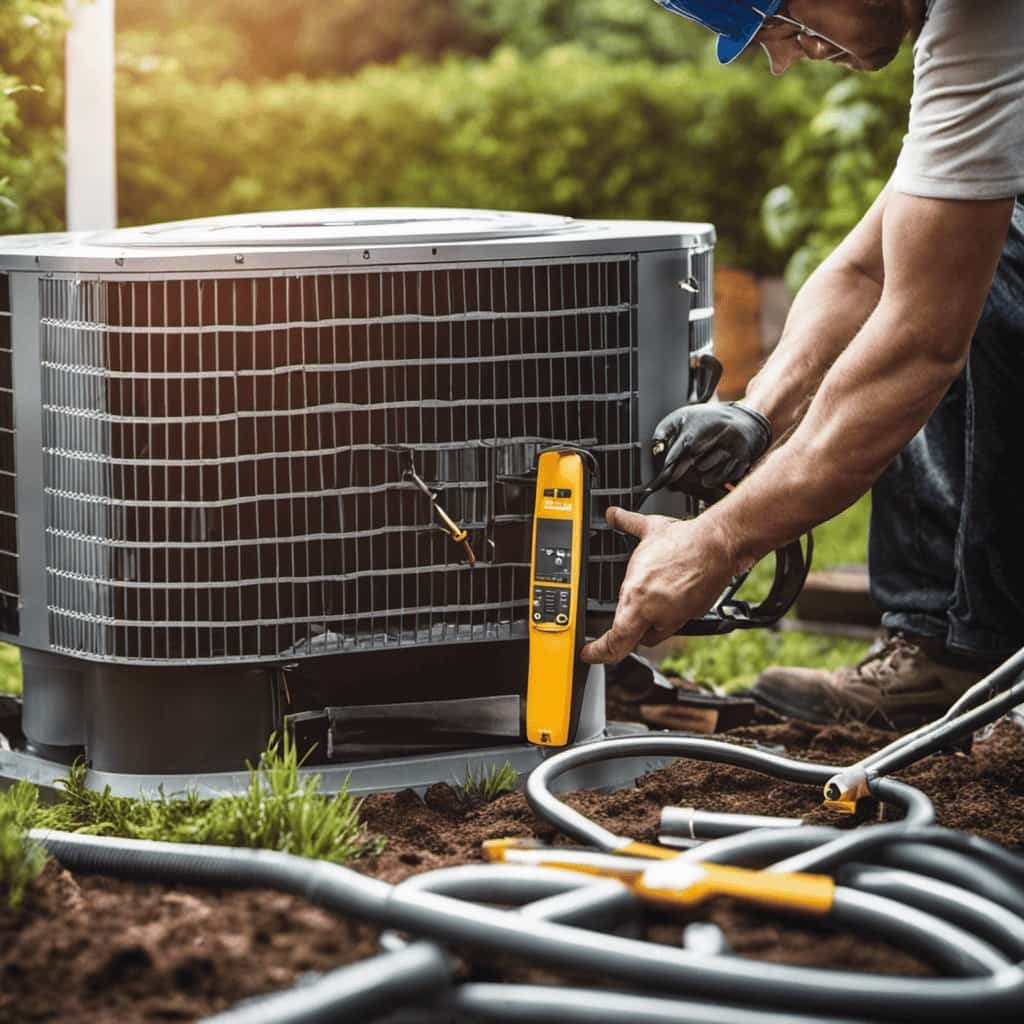
-
Check the outdoor temperature: If the temperature is below 40 degrees Fahrenheit, it’s normal for the heat pump to ice up. However, if the temperature is above 40 degrees and you see ice buildup, there might be an issue.
-
Inspect the defrost control board: This component controls the defrost cycle and should be in good working condition. If it’s faulty, it may prevent the heat pump from defrosting properly.
-
Clean the outdoor unit: Debris, such as leaves or dirt, can obstruct airflow and contribute to icing. Regularly clean the outdoor unit to prevent defrosting issues.
-
Check the refrigerant levels: Low refrigerant levels can lead to improper heat transfer and cause the heat pump to freeze up. Consult a professional to check and recharge the refrigerant if needed.
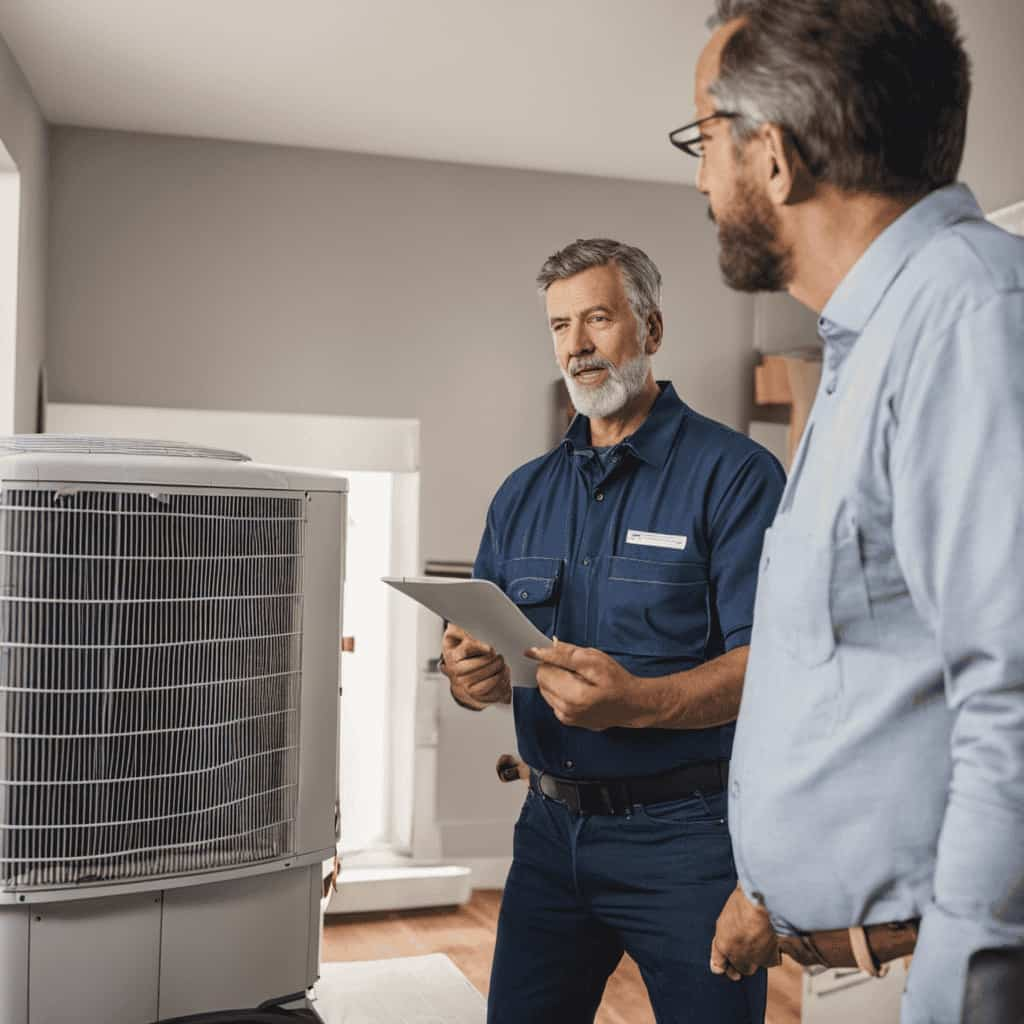
Resolving Noisy Heat Pump Operation
During our troubleshooting process, we discovered effective methods for resolving noisy heat pump operation. Heat pump noise reduction is a common concern for homeowners, as it can be bothersome and disruptive. By identifying the source of the noise and implementing the appropriate solutions, we can help restore peace and quiet to your home. The table below outlines some common sources of heat pump noise and the corresponding troubleshooting steps to resolve them:
| Source of Noise | Troubleshooting Steps |
|---|---|
| Loose components | Tighten or replace loose screws, bolts, or fasteners |
| Fan motor issues | Lubricate the motor or replace worn-out bearings |
| Refrigerant leaks | Repair or replace damaged refrigerant lines |
| Compressor problems | Clean or replace the compressor |
Addressing Heat Pump Cycling Problems
To mitigate heat pump cycling problems, we recommend regularly maintaining and cleaning the outdoor unit. This is crucial as a dirty outdoor unit can cause the heat pump to cycle more frequently, leading to inefficient operation and higher energy consumption. Here are four important steps to ensure optimal heat pump performance and temperature control:
-
Clean the outdoor coils: Accumulated dirt and debris on the coils can restrict airflow, reducing heat transfer efficiency. Regularly cleaning the coils with a soft brush or vacuum will improve airflow and reduce cycling issues.
-
Check the refrigerant levels: Low refrigerant levels can cause the heat pump to cycle more frequently as it struggles to maintain the desired temperature. A professional technician should inspect and recharge the refrigerant if necessary.
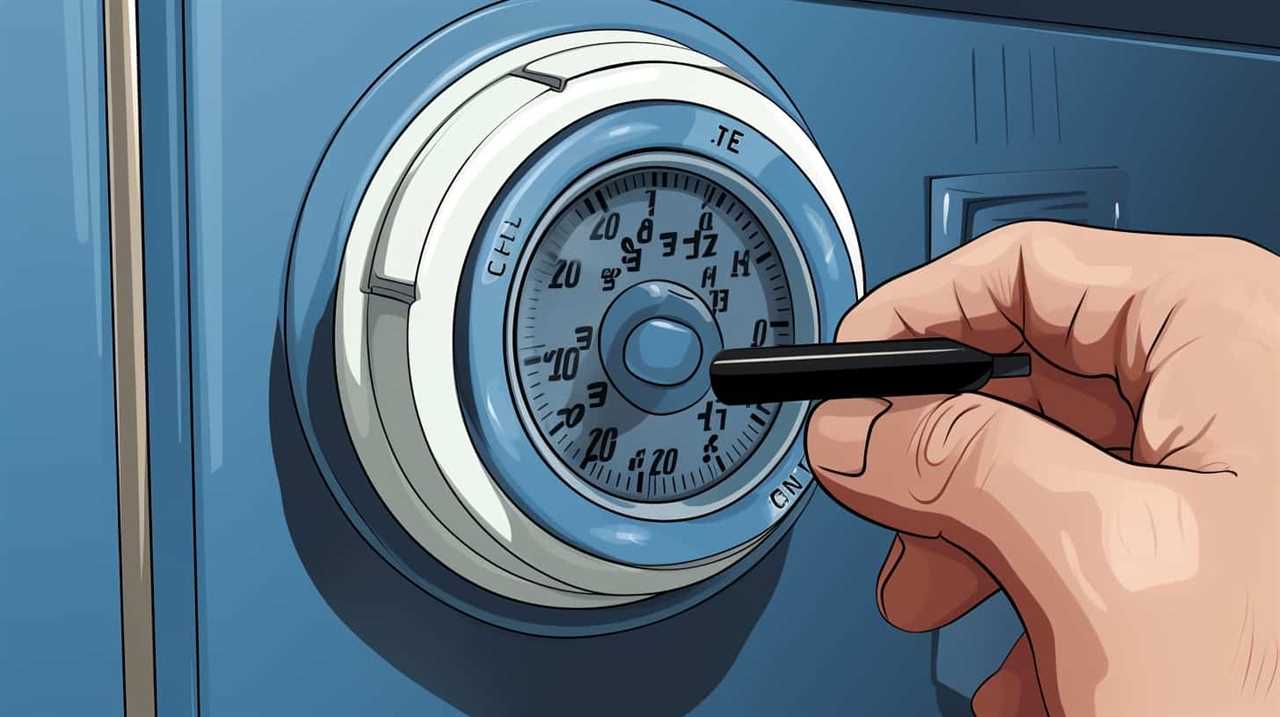
-
Inspect the air filters: Clogged or dirty filters can impede airflow, forcing the heat pump to work harder and cycle more frequently. Clean or replace the filters regularly to ensure optimal performance.
-
Schedule regular maintenance: Professional heat pump maintenance should be performed annually to identify and address any underlying issues that may be causing excessive cycling. This will help prolong the lifespan of the heat pump and improve its overall efficiency.
Frequently Asked Questions
How Can I Improve the Overall Efficiency of My Heat Pump?
To improve the overall efficiency of our heat pump, we can start by improving insulation in our home. Additionally, optimizing the thermostat settings can help regulate temperature and reduce energy consumption, ultimately increasing efficiency.
Is It Normal for My Heat Pump to Make a Humming Noise?
Yes, it is normal for heat pumps to make a humming noise. However, if the noise is excessive or disruptive, it may indicate a problem. Troubleshooting the issue and improving noise levels can help resolve this.

Can I Use My Heat Pump During Extremely Cold Weather?
Yes, you can use your heat pump during extremely cold weather. However, it’s important to perform regular heat pump maintenance to ensure optimal performance. Using a heat pump in cold weather offers benefits like energy efficiency and cost savings.
What Should I Do if My Heat Pump Is Blowing Warm Air Instead of Cold Air?
If your heat pump is blowing warm air instead of cold air, there are several troubleshooting steps you can take. Common causes include thermostat issues, refrigerant leaks, and dirty coils. Let’s dive into the details.
How Often Should I Have My Heat Pump Serviced?
Regular heat pump maintenance is crucial for optimal performance and longevity. We recommend scheduling a professional service at least once a year. Regular servicing ensures peak efficiency, reduces the risk of breakdowns, and improves indoor air quality.
Conclusion
In conclusion, maintaining the proper functioning of your heat pump is crucial for optimal cooling efficiency.
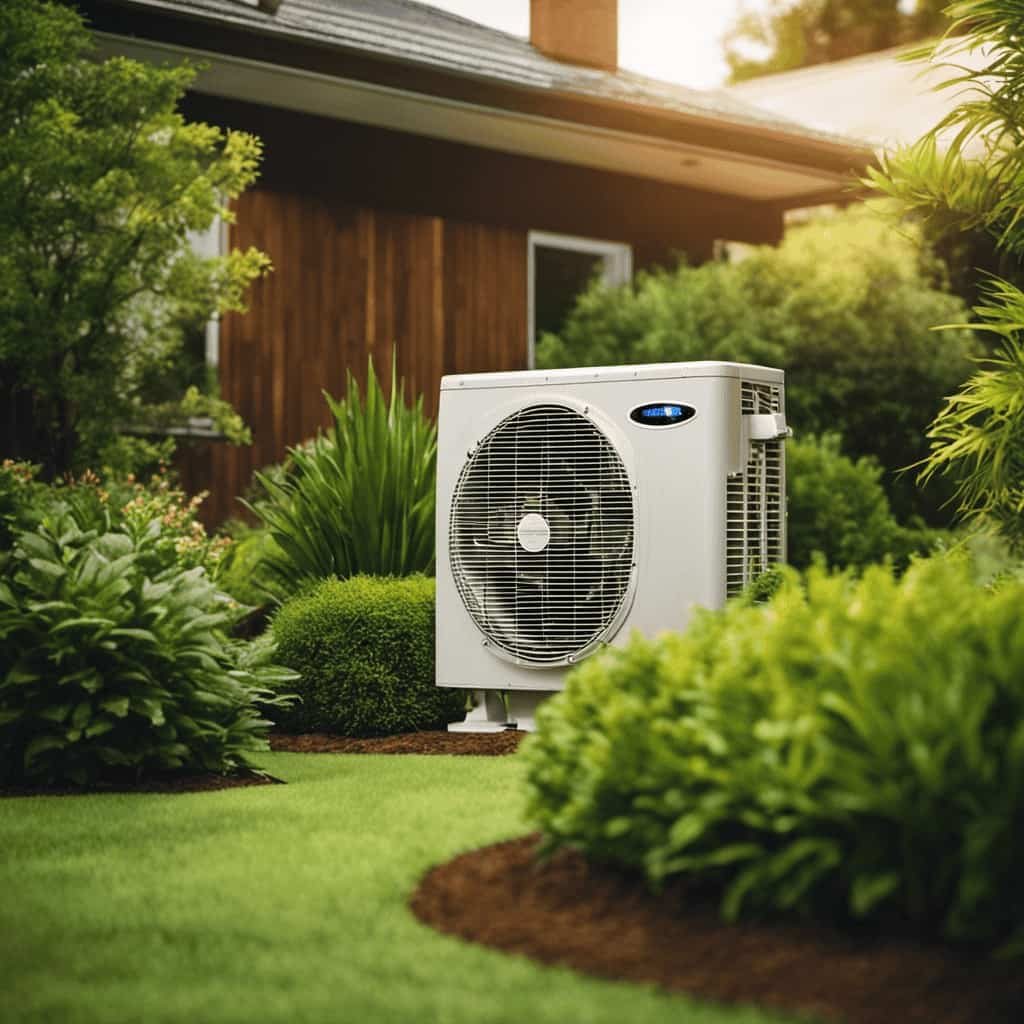
By addressing common issues such as refrigerant leaks, icing, and noisy operation, you can ensure the longevity and effectiveness of your heat pump system.
Just like a well-tuned instrument producing harmonious melodies, a well-maintained heat pump will create a comfortable and soothing environment in your home.
So, take the necessary steps to troubleshoot and resolve any problems, and enjoy the cool comfort your heat pump provides.



